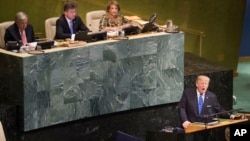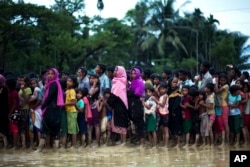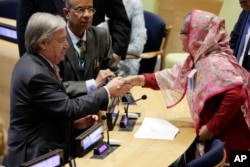With the United States poised to announce in the coming weeks how many refugees it will agree to accept in the new fiscal year, U.S. President Donald Trump told the United Nations on Tuesday that the U.S. will focus on keeping displaced people in their “home region” with an eye on eventual repatriation.
“We seek an approach to refugee resettlement that is designed to help these horribly treated people, and which enables their eventual return to their home countries to be part of the rebuilding process,” Trump told fellow world leaders at the annual meeting.
“For the cost of resettling one refugee in the United States, we can assist more than 10 in their home region,” he said, adding that the U.S. gives financial assistance to refugee host countries: “out of the goodness of our hearts, we offer financial assistance to hosting countries in the region, and we support recent agreements of the G-20 nations that will seek to host refugees as close to their home countries as possible. This is the safe, responsible and humanitarian approach.”
(The G20 declaration had promised to address “the distinct needs of refugees and migrants, in particular close to their region of origin.”)
As a policy, however, such a cost-based analysis fails to account for the fact that refugees who are selected through the U.N. system for resettlement in a third country like the United States, are chosen because they have exhausted all other remedies: they cannot return to their home country, and they cannot stay in their host country.
Report expected
With his statement Tuesday, Trump revived rhetoric about the financial aspect of resettlement that first appeared in the original travel ban, which in January called for a report on the “estimated long-term costs of the USRAP [U.S. Refugee Assistance Program] at the federal, state, and local levels.”
That language did not make it into the second version of the executive order, issued in March. Instead, it was included in a presidential memo the same day as the second travel ban was issued, ordering the report, as well as one on “the comparable cost of providing similar benefits [to refugees] elsewhere.”
In early September, a State Department spokesperson told VOA that the agency is leading those analyses. The results are expected this month.
“As the president requested, the reports will look at the estimated long-term costs of the USRAP at the federal, state, and local levels along with recommendations about how to curtail those costs, as well as how many refugees are being supported in countries of first asylum and those associated costs,” the spokesperson said.
A report published in June, however, showed that in taxes, adult refugees ultimately pay back the cost of their resettlement and other benefits over their first 20 years in the U.S.
Rohingya Muslims?
The absence from Trump's speech of the most recent refugee flashpoint — the estimated 400,000 Muslim minority Rohingya fleeing violence in majority-Buddhist Burma — was noted on social media Tuesday.
The prime minister of Bangladesh, which has received many of the fleeing Rohingya Muslims, said she spoke to Trump on Monday on the sidelines of the U.N. General Assembly about the number of displaced people entering her country, but expects no help from him given his decisions on refugees.
“He just asked how is Bangladesh. I said it's doing very well, but the only problem that we have is the refugees from Myanmar’,” Sheikh Hasina told Reuters in an interview. “But he didn't make any comment about refugees.”
“Already America declared that they will not allow any refugees,” Hasina said. “What I can expect from them, and especially [the] president. He already declared his mind ... so why I should ask?”
A senior White House official was unaware of the exchange, according to Reuters, but said Trump was deeply interested in the subject and that “he would definitely engage if it were brought up.”
By the numbers
The United States has long been the top provider of third-country resettlement; Trump came to office in January with a goal of dramatically cutting the so-called refugee ceiling, or the maximum number of refugees that would be allowed in for the fiscal year, which runs Oct. 1 to Sept. 30.
Through two executive orders, Trump mandated only allowing 50,000 refugees in FY2017, and the administration largely succeeded in scaling back dramatically from the ceiling of 110,000 set by then-President Barack Obama last September.
Arrival levels dropped dramatically in July and August to decade-low points, with the U.S. Supreme Court determining that for now, only refugees with “bona fide” family ties to the U.S. can come to the country.
As of Sept. 19, the U.S. has accepted 52,282 refugees this fiscal year, the majority during the last months of Obama's tenure, according to State Department data.
A 120-day temporary ban on refugee arrivals mandated by the travel ban is set to expire in October, with the future of the program uncertain in the new fiscal year.
VOA State Department correspondent Cindy Saine contributed to this report from Washington. Material from Reuters was also included in this report.











